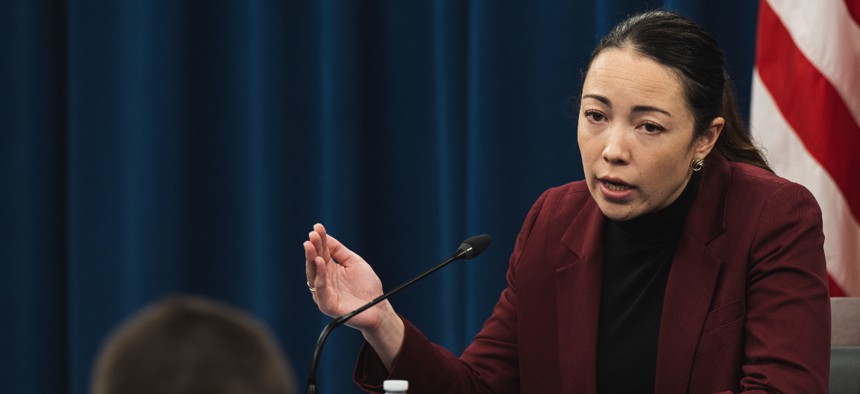
U.S. Central Command Chief Technology Officer Schuyler Moore conducts a press briefing on artificial intelligence and unmanned systems at the Pentagon, Washington, D.C., Dec. 7, 2022. Petty Officer 2nd Class Alexander Kubitza/U.S. Navy
What's Holding Up the US Military's Use of AI?
Two of the obstacles are spotty networks and inadequate data, CENTCOM's CTO says.
Even as the Department of Defense continues to promote the military’s adoption of artificial intelligence and machine learning technologies, there are a number of challenges—such as the adequate collection and use of high-quality data and network infrastructure breakdowns—that need to be addressed to enhance the effectiveness of these autonomous tools for frontline use, the chief technology officer for U. S. Central Command—or CENTCOM—said during a speech on Thursday.
During an event on artificial intelligence and the future of warfare held by SparkCognition Government Systems, Schuyler Moore—CENTCOM’s CTO—said that combatant commands’ implementation of AI tools and technologies looks vastly different “from a conceptual level for what makes it difficult.”
“If you think about data being the limiting factor for maturity and function of a model, we at the edge have found that network infrastructure and function is the limiting factor for adoption and use of anything,” Moore said. “We have found incredible examples of models that have exquisite capabilities, but we can't use them where we're at because there is not the compute power available, because the interface or the type of software is not available, because it doesn't run on the right classification of network. And so there are all these friction points that are at an underlying layer.”
The Pentagon has moved to set guidelines around the military’s adoption of AI in recent years, including through the release of DOD’s Responsible Artificial Intelligence Strategy and Implementation Pathway in June 2022 and the department’s Ethical Principles for AI that were adopted in February 2020. Recent changes to DOD directive 3000.09—or “Autonomy in Weapon Systems”—were also made in January to account, in part, for the department’s AI-related guidance.
But even as U.S. forces work to embrace AI technologies for frontline use—Moore noted that CENTCOM uses computer vision algorithms to help with targeting and anomalous behavior detection algorithms to identify potential adversaries—challenges around effective data collection continue to stymie the adoption of other autonomous resources.
“Data is really the fuel that allows these models to perform in a meaningful way, but in a lot of the areas that we operate, you don't even have the data to collect to then fuel a model,” Moore said, adding that the problem is often not having data “in the area on, below, above the sea to actually even know what's happening at all.”
To address this problem, Moore said that CENTCOM has used unmanned systems to collect data, noting that one of the conveniences of these technologies is “the fact that they are able to stay out for 200-plus days.”
“Whether it's with long endurance [unmanned aircraft systems], whether it's with high-altitude balloons—all of these—the point is to collect and suck up the data that allows you to do any of the fun modeling and analytics that we're talking about down the road,” she said.
Beyond minimal or ineffective data collection to support AI technologies, Moore said that “too much data can be the same as no data if I don't have a meaningful way of analyzing it, and particularly at speed.” And she added that the siloing of data assets in an “ungodly number of places in the department at different classification levels” can also prevent combatant commands from quickly adopting effective algorithms and AI tools.
“For our purposes, just sort of recurring analysis without a particular deadline is not the name of the game,” she added. “We need to be able to identify points of interest very quickly if we're going to take action on them in a meaningful way.”
Issues with the network infrastructure needed to support AI technologies and systems have also posed challenges for CENTCOM and other combatant commands. Moore said that CENTCOM has had “some really interesting, sometimes depressing, occasionally uplifting conversations with the services about the network infrastructure that we rely on—both here in the states and especially overseas—and the limitations and options that we have out there in terms of capacity.”
“If I've collected data at a certain point, and then I need to push it back to a home base where you can run analytics, and that pipe is severed, suddenly everything downstream of that stops,” she added. “Or, if you collected data, and then you get it to your home base where you can conduct analytics, but then suddenly, the analytics can't be pushed back to a headquarters that has to make a particular decision about how you act on something.”
Moore said that these are DOD-specific issues that cannot be effectively addressed by industry partners, but noted that the department is working to solve these challenges. She cited the creation of the army’s Task Force 39, the navy’s Task Force 59 and the air force’s Task Force 99 as branch-specific innovation hubs focused on adopting and experimenting with emerging technologies.
“The data fusion problem is not specific to CENTCOM,” she added. “The fights that we're having to have inside the department to navigate data sharing is something that all of us are going to have to fight. And so what we would like to do as a headquarters is fight those battles, allow other combatant commands to continue doing their jobs and then we can share the lessons learned over to them through the mechanisms that we’ve stood up.”




